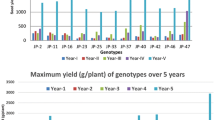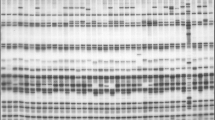Abstract
Balanites aegyptiaca has been identified as a source of seed oil for biodiesel feedstock. Diversity in its population based on morphological descriptors and seed oil yield has been studied in order to evaluate the variation, association of morphological descriptors with oil yield and inheritance of the traits to facilitate the plans for genetic improvement and its conservation. From seven agro-climatic regions, 56 accessions of B. aegyptiaca were studied to evaluate variability based on morphological descriptors, viz. height, girth, leaf, fruit, pericarp, mesocarp, nut and kernel. The data were subjected to ANOVA, simple measures of variation and D2 statistics. Genetic variability among morphological descriptors was recorded. High heritability (> 0.8) and genetic advance (~ 360%) make kernel weight a suitable marker for genetic improvement of B. aegyptiaca for oil yield. Cluster analysis revealed that cluster V (Jaipur, Sikar, Jodhpur, Dungarpur, Alwar and Kota regions) had high oil. Cluster II with the highest intracluster distance (10,239) was found to be the most suitable for genetic improvement. The population of B. aegyptiaca in Udaipur, Jaipur, Sikar, Jodhpur, Alwar and Dungarpur may be protected for in situ conservation. The study helps in designing strategy to get enhanced oil from B. aegyptiaca and its conservation.




Similar content being viewed by others
References
Asif S, Ahmad M, Zafar M, Ali N (2017) Prospects and potential of fatty acid methyl esters of some non-edible seed oils for use as biodiesel in Pakistan. Renew Sust Energ Rev 74:687–702
Saravanan AP, Mathimani T, Deviram G, Rajendran K, Pugazhendhi A (2018) Biofuel policy in India: a review of policy barriers in sustainable marketing of biofuel. J Clean Prod 193:734–747
Jain T, Singh G, Dwivedi G, Nandan G (2018) Study of emission parameter of biodiesel from non-edible oil sources. Mater Today Proc 5:3581–3586
Atabani AE, Silitonga AS, Ong HC, Mahlia TM, Masjuki HH, Badruddin IA, Fayaz H (2013) Non-edible vegetable oils: a critical evaluation of oil extraction, fatty acid compositions, biodiesel production, characteristics, engine performance and emissions production. Renew Sust Energ Rev 18:211–245
Deshmukh SJ, Bhuyar LB (2009) Transesterified Hingan (Balanites) oil as a fuel for compression ignition engines. Biomass Bioenerg 33:108–112
Chapagain BP, Yehoshua Y, Wiesman Z (2009) Desert date (Balanites aegyptiaca) as an arid lands sustainable bioresource for biodiesel. Bioresour Technol 100:1221–1226
Elfeel AA (2012) Effect of seed pre-treatment and sowing orientation on germination of Balanites aegyptiaca (L) Del. Seeds Am-Eu J Agri Environ Sci 12:897–900
Elfeel AA (2010) Variability in Balanites aegyptiaca var. aegyptiaca seed kernel oil, protein and minerals contents between and within locations. Agric Biol JN Am 2:170–174
Chapagain B, Wiesman Z (2005) Variation in diosgenin level in seed kernels among different provenances of Balanites aegyptiaca Del (Zygophyllaceae) and its correlation with oil content. Afr J Biotech 4:1209–1213
Saini MK, Sharma P, Prasad J, Kothari SL, Gour VS (2019) Quality assessment of oil and biodiesel derived from Balanites aegyptiaca collected from different regions of Rajasthan. Biocatal Biotransfor 101374:1–6
Gour VS, Sanadhya N, Sharma P, Parmar A, Datta M (2015) Biosurfactant characterization and its potential to remove sebum from hair. Ind Crops Prod 69:462–465
Mbow C, Chhin S, Sambou B, Skole D (2013) Potential of dendrochronology to assess annual rates of biomass productivity in savanna trees of West Africa. Dendrochronologia 31:41–51
Tilahun G, Kebede F, Haftu S (2015) Soil properties and carbon sequestration under desert date (Balanites aegyptiaca) in the lowlands of Northern Ethiopia. J Soil Sci Environ Manag 6:215–224
Seid H, Birhane E (2017) In agroforestry anecdotal to modern science. In: Dagar JC, Tewari VT (eds) Performance of some agroforestry trees in reclamation of salt-affected soils in the lowlands of Ethiopia. Springer, pp 497–515
Hall JB, Walker DH (1991) Balanites aegyptiaca: a monograph, school of agricultural and forest sciences. University of Wales, Bangor, p 1991
Ginwal HS, Rawat PS, Srivastava RL (2004) Seed source variation in growth performance and oil yield of Jatropha curcas Linn. in central India. Silvae Genet 53:186–192
Sunil N, Kumar V, Sivaraj N, Lavanya C, Prasad RB, Rao BV, Varaprasad KS (2009) Variability and divergence in Pongamia pinnata (L.) Pierre germplasm—a candidate tree for biodiesel. GCB Bioenergy 1:382–391
Tripathi A, Mishra DK, Shukla JK (2013) Genetic variability, heritability and genetic advance of growth and yield components of Jatropha (Jatropha curcas Linn.) genotypes. Trees 27:1049–1060
Temesgen H, Monleon VJ, Hann DW (2008) Analysis and comparison of nonlinear tree height prediction strategies for Douglas-fir forests. Can J For Res 38:553–565
Obiefuna JC (1979) Estimating leaf area of plantain. Sci Hortic 11:31–36
Singh RJ, Chaudhary BD (2014) Biometrical methods in quantitative genetic analysis. Kalyani Publication, Ludhiana
Parker KC, Trapnell DW, Hamrick JL, Hodgson WC, Parker AJ (2010) Inferring ancient Agave cultivation practices from contemporary genetic patterns. Mol Ecol 19:1622–1637
Kala S, Dubey SK (2014) Diversity in Balanites aegyptiaca: a lesser known tree species in the Yamuna ravines. Indian For 140:1142–1144
Ndoye M, Diallo I, Gassama YK (2004) Reproductive biology in Balanites aegyptiaca (L.) Del., a semi-arid forest tree. Afr J Biotech 3:40–46
Metougui ML, Mokhtari M, Maughan PJ, Jellen EN, Benlhabib O (2017) Morphological variability, heritability and correlation studies within an Argan tree population (Argania spinosa (L.) Skeels) preserved in situ. Int J Agric For 7:42–51
Wani TA, Kitchlu S, Ram G (2012) Genetic variability studies for morphological and qualitative attributes among Jatropha curcas L. accessions grown under subtropical conditions of North India. S Afr J Bot 79:102–105
Parker KC, Trapnell DW, Hamrick JL, Hodgson WC (2014) Genetic and morphological contrasts between wild and anthropogenic populations of Agave parryi var. huachucensis in south-eastern Arizona. Ann Bot 113:939–952
Rao GR, Shanker AK, Srinivas I, Korwar GR, Venkateswarlu B (2011) Diversity and variability in seed characters and growth of Pongamia pinnata (L.) Pierre accessions. Trees 25:725–734
Mishra AK, Yaday LN (1991) Genetic parameters and association analysis in linseed. Ind Agric Res 33:113–118
Jaisankar I, Sankaran M, Singh DR, Damodaran V (2014) Genetic variability and divergence studies in pod and seed traits of Pongamia pinnata (L.) Pierre., accessions in Bay Islands. J For Res 25:351–358
Acknowledgements
The corresponding author is grateful to Science and Engineering Research Board, New Delhi, for the financial assistance under the Young Scientist Scheme (File no: YSS/2014/000998). The authors are thankful to Dr. Paras Sharma, Dr. Kumar Sambhav Verma, Dr. Chandan Singh Rajpurohit, Dr. S.S. Meena, Mr. Shri Kant Wankhede, Mr. Sadul Ram and Mr. Pankaj Singh Chouhan for their valuable help extended during the survey and sample collection process. We acknowledge the help of Dr. Manoj Kumar, Amity University Rajasthan, Jaipur, for language improvement of this manuscript.
Author information
Authors and Affiliations
Corresponding author
Ethics declarations
Conflict of interest
The authors declare that they have no conflict of interest.
Additional information
Publisher's Note
Springer Nature remains neutral with regard to jurisdictional claims in published maps and institutional affiliations.
Significance Statement In Balanites aegyptiaca, genotypes with high oil yield can be identified based on leaf length and kernel weight out of 11 characters studied. Populations with high oil yield and genetic diversity have been identified in Rajasthan which can be used for genetic improvement and conservation of this native plant of desert.
Rights and permissions
About this article
Cite this article
Saini, M.K., Prasad, J., Raju, P.V.S. et al. Morphological Descriptors and Heritability as Markers for Oil Yield in Balanites aegyptiaca (L.) Del.: A Potential Biodiesel Xerophyte. Proc. Natl. Acad. Sci., India, Sect. B Biol. Sci. 91, 695–706 (2021). https://doi.org/10.1007/s40011-021-01270-x
Received:
Revised:
Accepted:
Published:
Issue Date:
DOI: https://doi.org/10.1007/s40011-021-01270-x




